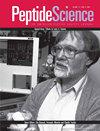合成和纯化利拉鲁肽的新方法
IF 1.7
4区 生物学
Q4 BIOCHEMISTRY & MOLECULAR BIOLOGY
引用次数: 0
摘要
利拉鲁肽由诺和诺德公司开发,用于治疗 2 型糖尿病和肥胖症。为生产这种药物设计了多种固相肽合成方案。然而,目前的方案价格昂贵,而且许多方案难以扩大规模。在这项研究中,我们开发出了一种生产利拉鲁肽的新型替代方案。该多肽通过 Fmoc/tBu 固相多肽合成法在 4-hydroxymethylbenzoyl-ChemMatrix (HMBA-CM) 树脂上拉长,并使用混沌剂氯化锂作为添加剂以防止多肽聚集。伸长后,通过两步程序去除侧链保护基团并从树脂中裂解肽。用 92.5% 的反式脂肪酸去除侧链保护基团,使未受保护的多肽附着在固体支持物上。彻底清洗树脂以去除杂质。接下来,用 0.1 N 的 NaOH 处理肽基树脂,实现肽的释放。这两步程序可确保获得高纯度的产品,而无需像以前的方案那样使用大量乙醚。最后,利拉鲁肽是通过疏水相互作用低压液相色谱法(HI-LPLC)纯化的,而不是使用已报道方法中昂贵的 RP-HPLC。这种简单而经济的方法不仅产量高、纯度高,而且克服了现有工艺的高成本和困难。本文章由计算机程序翻译,如有差异,请以英文原文为准。
A Novel Method for Liraglutide Synthesis and Purification
Liraglutide, developed by Novo Nordisk, is applied in Type 2 diabetes and obesity treatment. Several solid‐phase peptide synthesis protocols were designed for its production. However, current protocols are expensive and many of them are difficult to scale‐up. In this study, a novel alternative for liraglutide production was developed. The peptide was elongated by Fmoc/tBu solid‐phase peptide synthesis on 4‐hydroxymethylbenzoyl–ChemMatrix (HMBA‐CM) resin using the chaotropic agent LiCl as an additive to prevent peptide aggregation. After elongation, removal of side‐chain protecting groups and peptide cleavage from the resin was performed by a two‐stage procedure. Side‐chain protecting groups were removed with 92.5% TFA, leaving the unprotected peptide attached to the solid support. The resin was thoroughly washed to eliminate the contaminants. Next, peptide release was achieved by treating the peptidyl resin with NaOH 0.1 N. This two‐stage procedure assures a high‐purity product without the need of using a large amount of ether as in previous protocols. Finally, liraglutide was purified by hydrophobic interaction with low‐pressure liquid chromatography (HI‐LPLC) instead of using the expensive RP‐HPLC applied in reported methods. This simple and economic method resulted in a high yield and a purity product while overcoming the high cost and difficulties of current processes.
求助全文
通过发布文献求助,成功后即可免费获取论文全文。
去求助
来源期刊

Peptide Science
Biochemistry, Genetics and Molecular Biology-Biophysics
CiteScore
5.20
自引率
4.20%
发文量
36
期刊介绍:
The aim of Peptide Science is to publish significant original research papers and up-to-date reviews covering the entire field of peptide research. Peptide Science provides a forum for papers exploring all aspects of peptide synthesis, materials, structure and bioactivity, including the use of peptides in exploring protein functions and protein-protein interactions. By incorporating both experimental and theoretical studies across the whole spectrum of peptide science, the journal serves the interdisciplinary biochemical, biomaterials, biophysical and biomedical research communities.
Peptide Science is the official journal of the American Peptide Society.
 求助内容:
求助内容: 应助结果提醒方式:
应助结果提醒方式:


